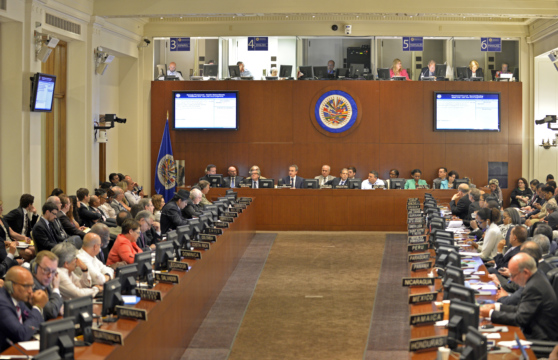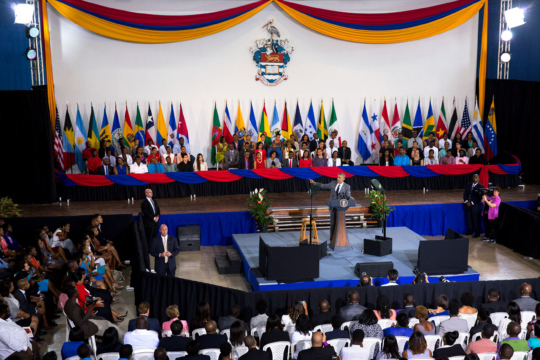
Reform the OAS
Secretary General Luis Almagro’s recent visibility is not enough to hide the deep problems the OAS is facing.
This post is also available in: Spanish
Many of the energy and climate commitments made at the Ninth Summit of the Americas last month focused on the promotion of a clean and just energy transition in the Western Hemisphere. In one of the more noteworthy pledges, five countries announced their intention to take part in the Renewables in Latin America and the Caribbean (RELAC) initiative: three as members (Barbados, Guyana, and Jamaica) and two as collaborators (Argentina and Brazil). These commitments, combined with the professed willingness of the United States to provide financial support and technical assistance, could renew regional efforts to decarbonize economies through the transformation of electricity systems. Beyond the rhetoric of these pledges, though, specific questions are raised: What does the RELAC initiative consist of? What challenges will it face in implementation? In achieving its goals, what new opportunities could emerge?
Colombia launched RELAC during the 2019 UN Climate Action Summit with the aim of accelerating the carbon neutrality of electricity systems in Latin America and the Caribbean (LAC), setting an ambitious overarching target for over 70 percent of power generation to come from renewables by 2030. With a regional baseline of around 59 percent in 2019, such a target requires doubling the growth rate of both renewable installed capacity and the share of renewables in total electricity generation over the period 2020-2030 compared to the previous decade.
In addition to Colombia, two other regional energy transition leaders, Chile and Costa Rica, originally collaborated to promote this initiative. Since then, a total of 15 countries in the region have become members and established their own renewable energy targets. Technical coordination and assistance are provided by the Inter-American Development Bank and the Latin American Energy Organization in collaboration with a group of high-level energy agencies such as the International Energy Agency, the International Renewable Energy Agency, and the US National Renewable Energy Laboratory, among others. With the support of these actors, member countries benefit from four project instruments: 1) tailoring of regulatory and normative frameworks; 2) coordination and optimization of energy agencies; 3) financial connections between project developers and funders; and 4) provision of a platform for monitoring climate action.
The enabling context driving the initiative is the fact that LAC’s energy mix is considered “the world’s cleanest” given the high share of hydropower in electricity generation (around 45 percent in 2019). Nevertheless, the growth of hydropower, particularly large dams, has been stalled for at least five years due to recurring governance issues (such as citizen opposition, corruption, or lack of prior consultation), acute socio-ecological damage, and water stress exacerbated by climate change. Within this context, RELAC focuses on mitigating climate change while improving the resilience, competitiveness, and sustainability of the electricity sector through diversification and expansion of renewable energy sources, especially non-conventional ones (i.e., excluding large hydropower projects).
However, a variety of challenges impede the initiative’s implementation. For one, the initiative is complicated by disparities in the region’s national energy profiles. Significant differences in natural resource endowments and economic models have contributed to the uneven development of energy sources across the region. While some countries have an overwhelming renewable installed capacity (such as Paraguay, with 100 percent renewable energy largely sourced from hydroelectric dams such as Itaipú) or an extraordinary renewable resource potential (such as Chile, whose Atacama Desert has one of the highest levels of solar radiation in the world), other countries are extremely dependent on fossil fuels for power generation (such as Bolivia and Trinidad and Tobago, which is not yet a member of RELAC). Such differences have led to divergent levels of readiness for the transition to renewables which, reinforced by fossil fuel path dependence (i.e., the chronic reliance of some countries, Bolivia and Trinidad & Tobago among them, on fossil fuels not only for producing electricity, but as a key economic sector), affect the level of climate ambition among LAC countries (including their interest in participating in the initiative).
A second challenge is regional fragmentation and asymmetry of national goals. While RELAC seeks to foster a collective effort that recognizes distinct national contexts and resource endowments, differing domestic policies have led to highly varied energy transition pathways. While some countries like Uruguay and Costa Rica have bet heavily on renewables, the development strategies of other countries are based on boosting hydrocarbons. In the context of RELAC, this means that, although 15 countries have signed on, the initiative currently covers less than half of regional greenhouse gas (GHG) emissions—the region’s three largest emitters (Brazil, Mexico, and Argentina) are not full members yet. Whereas Brazil and Argentina have announced their intention to join the initiative in an ambiguous “collaborator” role, Mexico remains completely on the sidelines. Chronic political instability, energy policy volatility, and geopolitical uncertainty (such as that produced by Russia’s invasion of Ukraine) are additional factors that hinder the achievement of renewables targets regionally.
A third and final challenge to RELAC concerns the creation of healthy investment environments across all LAC countries, including those historically left behind. In 2021, three countries (Brazil, Chile, and Colombia) accounted for 88.78 percent of investments in renewables, with Brazil taking the lion’s share (68.75 percent of the regional total). Deconcentrating these investment flows to foster equitable development of renewables across the region requires adapting regulatory and normative frameworks to attract investors, in accordance with RELAC’s first “project instrument.” That being said, difficulties persist even among the most prepared countries. While the least advanced countries in the region have a low institutional capacity to develop regulations that improve investor confidence (as in Central America’s “Northern Triangle” or in some Caribbean islands), most of the better prepared countries still struggle with issues like environmental licensing and prior consultation with local communities. These challenges frequently delay the development of utility-scale projects, as is the case for socio-environmental conflicts associated with wind farms in La Guajira, Colombia, or in the Isthmus of Tehuantepec in Oaxaca, Mexico.
In addressing these challenges, however, RELAC presents an opportunity to transform electricity systems while improving energy equity regionwide. First, it offers a chance to foster a more inclusive and resilient development of renewable energies. On the one hand, it can right the wrongs of large hydro, notably regarding socio-environmental conflict resolution and human rights abuses in the renewable energy sector. This is significant given that, between 2010 and 2020, 61 percent of recorded human rights abuses linked to this sector worldwide were found in LAC. On the other hand, RELAC can trigger distributive justice actions in order to achieve, among other things, the ‘last mile’ in universal access to electricity (e.g., through solar microgrids or kits of photovoltaic panels and batteries for non-interconnected areas) and tackle energy poverty phenomena, including the use of rudimentary fuels for cooking. This approach has the potential to incentivize an equitable expansion of renewable capacity that minimizes conflicts between local communities and energy companies.
Second, RELAC could foster integration of energy systems, bridging intra-regional gaps and strengthening energy security. One way to advance these objectives is by improving access to financing in the short term, e.g., through agreements like a recent commitment by regional development banks to mobilize up to $50 billion in climate financing over the next five years. It is also key to harness RELAC to support technical assistance and the regional sharing of experiences in order to achieve the policy and regulatory adjustments required by each member country. Additionally, enhancing energy security requires collective, long-term efforts to leverage differences in energy resource endowments to build a robust, sustainable, and secure regional energy system that mitigates LAC’s risks related to shocks to global energy markets and to the impacts of climate change. For example, actions like interconnecting national electricity grids and upgrading and modernizing transmission infrastructure are critical. Throughout these efforts, an active role for the United States will be a decisive factor given its financial and technical resources.
Finally, this initiative provides an outstanding opportunity to align regional energy and climate policies. LAC only contributes to 7 percent of global GHG emissions—55 percent of which come from the energy sector (23 percent less than the world average). Nevertheless, setting the region on a deep decarbonization pathway is essential to keep alive the goal of limiting global warming to 1.5ºC above pre-industrial levels. The engagement of Mexico, Brazil, and Argentina will be crucial to such efforts, making the intention of the latter two to collaborate with the RELAC initiative a potentially considerable, albeit uncertain, step forward. RELAC can act as a framework for correlating renewable targets with Nationally Determined Contributions under the Paris Agreement and increasing climate ambition through international cooperation. Ultimately, that is the golden opportunity this initiative brings to the table: to make consistent and coordinated steps towards making LAC a global champion of climate action and sustainable development.
How Realistic Are Mexico’s Climate Commitments?
West Virginia v. EPA: Implications for the Americas and US Climate Diplomacy
Experts and officials discuss LAC energy policy
Secretary General Luis Almagro’s recent visibility is not enough to hide the deep problems the OAS is facing.
When leaders from nearly all the countries of the Americas gather in Lima, Peru next week, the unique circumstances may lead to a historic event: the first Summit of the Americas defined by honesty about the fundamental disagreements that shape the relationships among the United States, Canada, Latin America, and the Caribbean.
The Dialogue’s pioneering work has made significant contributions to the advancement of women in leadership, the promotion of reproductive rights and health, and the reduction of violence against women. However, these issues remain extant in the region, emphasizing the need to continue conducting research and analysis in each of these key areas of concern to women and crucial to the health of the region’s democracies.

